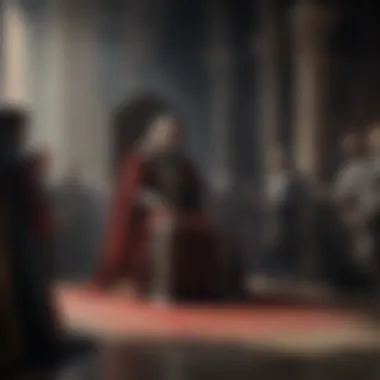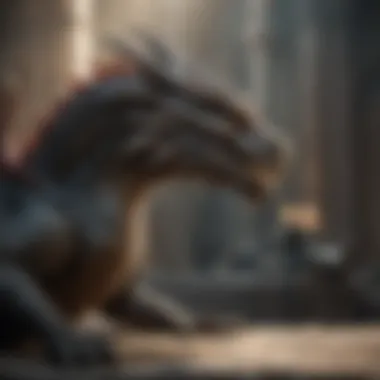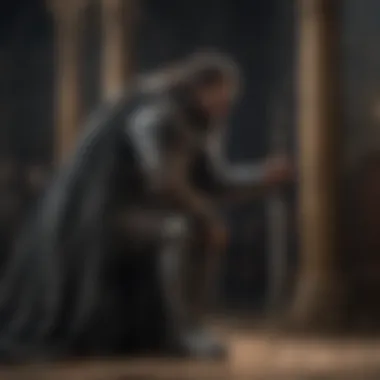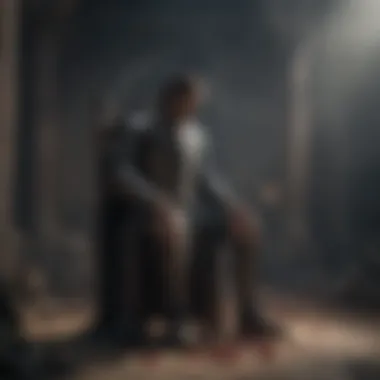Unveiling the Intricacies of Bending a Knee in the Game of Thrones Realm


Character Dissections
In delving into the art of bending a knee in Game of Thrones, it is imperative to conduct a detailed analysis of key characters who have been pivotal in shaping the narrative of the series. Characters such as Ned Stark, Cersei Lannister, and Daenerys Targaryen exhibit diverse approaches when it comes to matters of loyalty and power. Their choices to kneel or stand tall reveal profound insights into their motivations and the complex web of relationships that define Westerosi politics. Analyzing their character development throughout the series elucidates how bending a knee or refusing to do so can have far-reaching consequences that ripple across the overarching storyline.
Episode Breakdowns
Recapping significant events in each episode where characters either bend the knee or resist the call for submission provides a lens through which to explore the underlying themes and symbolism of power dynamics. Moments such as Jon Snow's decision to bend the knee to Daenerys Targaryen or Sansa Stark's refusal to kneel before Cersei Lannister are key points that illuminate the power struggles at play. Each decision carries weighty implications for the characters' future trajectories and the alliances they forge or break. Unpacking these key moments fosters a deeper understanding of how bending a knee serves as a visual representation of submission, defiance, or strategic maneuvering in the ruthless game of thrones.
Lore Explorations
Delving into the rich history and lore of Westeros uncovers the roots of the practice of bending the knee and its significance in the cultural tapestry of the realm. Within the annals of Westerosi history lie hidden details and connections that shed light on the origins of this ritual gesture and its evolution over time. Exploring the cultural and mythical aspects intertwined with the act of bending a knee enriches the narrative tapestry, providing context for the power dynamics and societal norms that dictate when and why a character chooses to kneel. By immersing ourselves in the lore of Westeros, we can unearth the deeper meanings embedded in the simple yet profound act of bending a knee.
Fan Theories
Compiling popular and intriguing fan theories surrounding the act of bending a knee in Game of Thrones offers a speculative avenue to ponder the potential motivations and outcomes of pivotal moments in the series. Through evaluating these theories based on evidence from the show, fans can engage in lively debates on the true intentions behind characters' decisions to submit or rebel. Speculating on future plot developments fueled by these fan theories adds another layer of anticipation and excitement for viewers eager to unravel the intricacies of bending a knee in the intricate tapestry of Game of Thrones.
Introduction:
In the context of the esteemed series, Game of Thrones, the act of bending a knee holds a crucial significance that permeates the intricate dynamics of power, loyalty, and submission within the realm of Westeros. This article aims to dissect the multifaceted meanings and implications of this gesture, shedding light on its symbolic weight and strategic relevance in the game of thrones.
Setting the Stage:
Historical Context:
Delving into the historical backdrop against which bending a knee unfolds, we unravel the tapestry of events that have shaped the power structures and alliances in Westeros. The historical context provides a rich foundation for understanding the significance of this act, showcasing centuries-old traditions and conflicts that continue to influence the present. Its portrayal of ancient rivalries and noble lineages adds depth to the narrative, offering a historical lens through which viewers can analyze the characters' motivations and actions.
Political Intrigues:
Exploring the political machinations woven into the fabric of Westeros, the realm of Game of Thrones is replete with intrigue, manipulation, and power struggles. Political intrigues serve as the backdrop against which bending a knee operates, highlighting the nuanced relationships and strategic calculations that dictate allegiances and betrayals. The intricate web of alliances and rivalries underscores the high stakes involved in this gesture, shaping the fates of individuals and kingdoms alike.
Defining the Gesture:


Symbolism of Submission:
At the heart of bending a knee lies the profound symbolism of submission, where individuals acknowledge a higher authority or power. This gesture signifies humility, fealty, and deference, reflecting societal norms of hierarchy and obedience. The symbolic resonance of submission evokes themes of control and power dynamics, illustrating the complexities of loyalty and servitude in a world driven by ambition and conquest.
Formal Protocols:
Embedded within the formal protocols of Westerosi society, bending a knee adheres to strict ceremonial customs and traditions. These protocols dictate the manner in which vassals pay homage to their lieges, emphasizing respect and compliance within a feudal framework. The formal gestures of bending the knee underscore the performative aspect of power dynamics, where outward displays of loyalty and obedience hold significant political and social ramifications.
Power Dynamics
Power dynamics in the world of Game of Thrones play a pivotal role in shaping alliances, enforcing authority, and determining the fate of characters. The intricate balance of power between houses and individuals sets the tone for political maneuvering and strategic decisions across Westeros. Understanding power dynamics is crucial for interpreting characters' actions and motivations, revealing hidden agendas and underlying tensions that drive the narrative forward. Whether through displays of loyalty or acts of betrayal, power dynamics permeate every aspect of the Game of Thrones universe.
Loyalty vs. Betrayal
Pledging Allegiance
Pledging allegiance holds immense significance in Game of Thrones, serving as a formal declaration of loyalty and forging alliances. Characters often swear fealty to a liege lord or ruler, binding themselves to a higher authority in exchange for protection or favor. This act symbolizes trust, solidarity, and commitment, establishing a foundation for relationships and power dynamics within the realm. However, pledging allegiance can also lead to vulnerabilities, as betrayal or abandonment carries severe consequences in a world where oaths are sacrosanct.
Consequences of Refusal
Refusing to pledge allegiance can have dire repercussions in the ruthless landscape of Game of Thrones. It signals defiance, disloyalty, or a challenge to established authority, inviting conflict and condemnation from those in power. Characters who reject allegiances risk isolation, retribution, or even death, as loyalty is a currency that holds immense value in securing alliances and maintaining influence. The consequences of refusal highlight the high stakes involved in navigating the intricate web of loyalties and betrayals that define the power dynamics of Westeros.
Authority and Obedience
Hierarchy in Westeros
The hierarchical structure in Westeros dictates social order, defining each individual's place within the feudal system. Noble houses adhere to strict hierarchies based on birthright and prestige, with power concentrated in the hands of lords and rulers. Understanding this hierarchy is essential for grasping the power dynamics at play, as loyalty and obedience flow upwards towards those in positions of authority. The rigid social stratification shapes interactions, decisions, and conflicts, underscoring the importance of status and lineage in determining power dynamics.
Enforcement of Rule
The enforcement of rule is a cornerstone of maintaining order and authority in the Seven Kingdoms. Rulers rely on enforcement mechanisms such as laws, justice systems, and military might to uphold their sovereignty and quell dissent. Compliance with established norms and commands is expected from subjects and vassals, ensuring stability and loyalty within the realm. However, the enforcement of rule can also breed resentment and resistance, leading to rebellion or subversion against tyrannical leaders. Balancing enforcement with legitimacy is crucial in fostering obedience and loyalty among the populace, reflecting the intricate dance of power dynamics in Game of Thrones.


Characters' Perspectives
In this section, we delve into the pivotal perspective of characters within Game of Thrones, shedding light on their motivations, alliances, and conflicts in the context of bending a knee. Understanding the characters' viewpoints unveils a layer of complexity in their decisions and actions. Through their perspectives, we grasp the intricacies of power dynamics and the significance of loyalty and betrayal in this intricate game of thrones.
Major Players
Ned Stark
Ned Stark, a character symbolizing honor and integrity, plays a crucial role in the narrative of Game of Thrones. His unwavering principles and commitment to justice serve as a moral compass amidst the political turmoil. Ned Stark's insistence on nobility and honesty in a realm marred by deception offers a stark contrast to the intrigues of the court. His tragic end highlights the consequences of naivety and trust in a treacherous game.
Daenerys Targaryen
Daenerys Targaryen, the embodiment of resilience and determination, represents a powerful force in the battle for supremacy. Her journey from exile to reclaiming her birthright showcases themes of strength and perseverance. Daenerys’ strategic acumen and unwavering belief in her destiny shape her interactions with other characters. However, her relentless pursuit of power raises questions about the cost of achieving ambition in a ruthless world.
Impact on Relationships
Allies and Foes
The dynamics of alliances and rivalries in Game of Thrones exemplify the ever-shifting landscape of power struggles. Characters navigate intricate networks of friends and enemies, where loyalty can be a rare commodity. The alliances formed based on mutual interests and betrayals driven by hidden agendas serve as a testament to the fragile nature of trust in the game of thrones.
Trust and Deception
Trust and deception permeate every relationship within the Game of Thrones universe, shaping destinies and alliances. The blurred lines between sincerity and manipulation underscore the challenges of discerning true motives in a world filled with double-crossing and subterfuge. Characters often tread a fine line between placing faith in others and safeguarding themselves against potential betrayal, showcasing the delicate balance of trust and deception in Westeros.
Strategic Alliances
Are integral to the tapestry woven by [Game of Thrones]. These alliances form the backbone of power play within the tumultuous realm of Westeros. Whether forged out of necessity or ambition, strategic alliances serve as the bedrock upon which empires rise and fall. They embody calculated decisions and intricate relationships, where one misstep can lead to catastrophic consequences. In the intricate dance of politics and power, alliances are the keys to unlocking doors to realms unknown. Each alliance is a delicate balance of power dynamics, loyalties tested, and betrayals anticipated.
Machiavellian Tactics
Game of Thrones:


Within the realm of strategy and manipulation, [Game of Thrones] excels in portraying the ruthless machinations of power. It embodies the essence of cunning, deceit, and calculated moves in a world where the stakes are as high as the towering walls of the Red Keep. The show astutely captures the complexities of human nature, where alliances shift like sand in a desert storm and betrayal lurks behind every exchange of words. Its portrayal of political intrigue and elaborate schemes sets the stage for analyzing the intricate dynamics of bending a knee in the game of thrones.
Survival Strategies:
Survival in Westeros demands more than physical strength or noble birth; it requires strategic acumen and the ability to navigate treacherous waters with precision. Survival strategies in this brutal landscape encompass a myriad of tactics - from forming temporary alliances to sacrificing pawns in the larger game. The art of survival lies in deception, foresight, and a keen understanding of one's adversaries. By delving into the survival strategies of key players, one can unravel the intricate web of power dynamics that govern the Seven Kingdoms.
Betrayals and Repercussions
Broken Pledges:
In a world where oaths are sworn in blood and honor is a fragile commodity, broken pledges reverberate like thunder in the stormy skies of Westeros. The repercussions of treachery are felt far and wide, shattering alliances and leaving scars that may never heal. The broken pledges of characters in Game of Thrones serve as cautionary tales, reminding us of the fragility of trust and the swift descent from grace to ruin.
Retribution:
Retribution is the cold embrace of justice in a world where mercy is often seen as weakness. The swift sword of retribution cuts through deceit and betrayal, restoring balance to a world steeped in chaos. It is the final act in the tragic dance of power, where consequences are paid in full and debts settled with steel and fire. The retribution meted out in Game of Thrones paints a bleak picture of a world where vengeance is a currency more valuable than gold.
Cultural Implications
Exploring the profound impact of cultural implications within the context of bending a knee in Game of Thrones is essential to comprehend the intricate dynamics of this symbolic gesture. Cultural nuances play a pivotal role in shaping the significance of bending the knee, reflecting deeply ingrained traditions, values, and belief systems prevalent in the fictional world of Westeros. The interplay between various cultural elements such as religious rites, ceremonial gestures, and societal norms significantly influences the interpretation and reception of this act of submission.
Religious Rites
Faith of the Seven
Delving into the Faith of the Seven unveils a central aspect of religious practices in Westeros and its contributions to the overarching theme of bending the knee. This multifaceted belief system embodies the complexity of human spirituality, with its seven aspects representing distinct facets of life. The piety towards the Seven ensures a moral compass for individuals, influencing decisions and actions related to allegiance and loyalty. The structured nature of this faith provides a sense of order and divine guidance, contributing to the framework within which bending the knee is not merely a physical act but a spiritual commitment driven by faith and reverence.
Old Gods
Exploring the reverence towards the Old Gods sheds light on a contrasting yet equally significant religious aspect affecting the practice of bending the knee in Game of Thrones. The Old Gods symbolize nature, primal forces, and ancient wisdom, emphasizing a connection to the land and heritage. Followers of the Old Gods find solace in tradition and ancestral ties, grounding their actions in reverence for the past. This deep-rooted faith underscores a different perspective on submission and allegiance, intertwining cultural heritage with mystical reverence, adding layers of complexity to the dynamics of bending a knee in the context of ancient traditions and spiritual beliefs.
Ceremonial Gestures
Coronation Ceremonies
Examining the role of coronation ceremonies in Game of Thrones unravels the ceremonial pomp and regal customs that infuse the act of bending the knee with grandeur and legitimacy. Coronations mark pivotal moments of transition and power shifts, where bending the knee signifies fealty and acceptance of leadership. The intricate rituals surrounding coronations highlight the symbolic transfer of authority and the consolidation of power, shaping political alliances and dynastic successions. The splendor of coronation ceremonies elevates bending the knee to a ceremonial gesture laden with symbolic weight, underscoring the heft of tradition and legitimacy in a world driven by ambition and intrigue.
Feudal Customs
Exploring the feudal customs in Game of Thrones illuminates the socio-political framework within which bending the knee operates, shaping power dynamics and relational hierarchies. Feudal customs dictate protocols of vassalage and fealty, outlining the responsibilities and obligations tied to sworn allegiances. Bending the knee within feudal contexts signifies acceptance of subordination and adherence to hierarchical structures, emphasizing the reciprocal nature of allegiance and protection. The feudal system embeds the act of submission within intricate webs of duty and honor, underscoring the nuanced interplay between power, loyalty, and self-interest inherent in bending the knee within the feudal society of Westeros.



